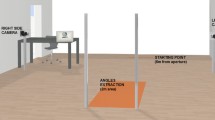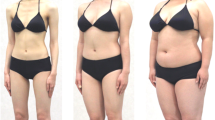Abstract
Individuals with anorexia nervosa (AN) experience pronounced body image distortion in combination with a pernicious desire to maintain a dangerously low body weight. Relatively little is known, however, about the mechanism underlying body image distortion in AN. Despite having normal visual perception, individuals with AN both feel and see themselves as large-bodied and show deficits in interoception and haptic perception, suggesting a potential deficit in visual and tactile integration. The size–weight illusion (SWI) arises when two objects of equal weight but different sizes are held. Typical individuals experience a strong and robust illusion that the smaller object feels much heavier than the larger object because of an implicit assumption that weight scales with size. The current study compared the strength of the SWI in individuals with AN to healthy control participants. Individuals with AN exhibited a markedly reduced SWI relative to controls, even though their ability to discriminate weight was unaffected. Because the SWI is strongly modulated by visual appearance, we believe our finding reflects decreased integration of visual and proprioceptive information in anorexia. This finding may explain the puzzling observation that visual perception of the body in a mirror does not correct an AN patient’s distorted body image. We speculate that methods to correct visuo-proprioceptive integration in constructing body image may help rehabilitate patients’ judgments of size and weight regarding their own bodies. We also suggest that a dysfunction in interactions between inferior parietal lobule (concerned with body image), insula, and hypothalamus may underlie AN.



Similar content being viewed by others
References
Alais D, Burr D (2004) The ventriloquist effect results from near-optimal bimodal integration. Curr Biol 14(3):257–262
Amazeen EL, Turvey MT (1996) Weight perception and the haptic size–weight illusion are functions of the inertia tensor. J Exp Psychol Hum Percept Perform 22(1):213–232
American Psychiatric Association (2000) Diagnostic and statistical manual of mental disorders (4th edn, text rev). American Psychiatric Association, Washington, DC
Anderson NH (1970) Averaging model applied to the size–weight illusion. Percept Psychophys 8:1–4
Birmingham CL, Su J, Hlynsky JA, Goldner EM, Gao M (2005) The mortality rate from anorexia nervosa. Int J Eat Disord 38:143–146
Blechert J, Ansorge U, Tuschen-Caffier B (2010) A body-related dot-probe task reveals distinct attentional patterns for bulimia nervosa and anorexia nervosa. J Abnorm Psychol 119:575–585
Buckingham G, Goodale MA (2010) Lifting without seeing: the role of vision in perceiving and acting upon the size weight illusion. PLos One 5:e9709
Casper RC, Halmi KA, Goldberg SC, Eckert ED, Davis JM (1979) Disturbances in body image estimation as related to other characteristics and outcome in anorexia nervosa. Br J Psychiatry 134:60–66
Charpentier A (1891) Analyse experimentale: De quelques elements de la sensation de poids. Archives de Physiologie Normale et Pathologique 3:122–135
Chouinard PA, Large ME, Chang EC, Goodale MA (2009) Dissociable neural mechanisms for determining the perceived heaviness of objects and the predicted weight of objects during lifting: an fMRI investigation of the size–weight illusion. Neuroimage 44:200–212
Critchley M (1953) The parietal lobes. Edward Arnold & Co., London
Ellis RR, Lederman SJ (1993) The role of haptic versus visual volume cues in the size–weight illusion. Atten Percept Psychophys 53(3):315–324
Ellis RR, Lederman SJ (1998) The golf-ball illusion: evidence for top-down processing in weight perception. Perception 27:193–201
Epstein J, Wiseman CV, Sunday SR, Klapper F, Alkalay L, Halmi KA (2001) Neurocognitive evidence favors “top down” over “bottom up” mechanisms in the pathogenesis of body size distortions in anorexia nervosa. Eat Weight Disord 6(3):140–147
Fassino S, Pierò A, Gramaglia C, Abbate-Daga G (2004) Clinical, psychopathological and personality correlates of interoceptive awareness in anorexia nervosa, bulimia nervosa and obesity. Psychopathology 37:168–174
Flanagan JR, Beltzner MA (2000) Independence of perceptual and sensorimotor predictions in the size–weight illusion. Nat Neurosci 3:737–741
Gescheider GA (1997) Psychophysics: the fundamentals. Lawrence Erlbaum Associates, Mahwah
Grandy MS, Westwood DA (2006) Opposite perceptual and sensorimotor responses to a size–weight illusion. J Neurophysiol 95:3887–3892
Grunwald M, Ettrich C, Krause W, Assmann B, Daehne A, Weiss T, Gertz H-J (2001) Haptic perception in anorexia nervosa before and after weight gain. J Clin Exp Neuropsychol 23:520–529
Grunwald M, Ettrich C, Busse F, Assmann B, Daehne A, Gertz H-J (2002) Angle paradigm: a new method to measure right parietal dysfunctions in anorexia nervosa. Arch Clin Neuropsychol 17:485–496
Guardia D, Lafargue G, Thomas P, Dodin V, Cottencin O, Luyat M (2010) Anticipation of body-scaled action is modified in anorexia nervosa. Neuropsychologia 48:3961–3966
Hoek HW, van Hoeken D (2003) Review of the prevalence and incidence of eating disorders. Int J Eat Disord 34:383–396
Jenmalm P, Schmitz C, Forssberg H, Ehrsson HH (2006) Lighter or heavier than predicted: neural correlates of corrective mechanisms during erroneously programmed lifts. J Neurosci 26:9015–9021
Kawai S, Henigman F, MacKenzie CL, Kuang AB, Faust PH (2007) A reexamination of the size–weight illusion induced by visual size cues. Exp Brain Res 179:443–456
Kaye WH, Fudge JL, Paulus M (2009) New insights into symptoms and neurocircuit function of anorexia nervosa. Nat Rev Neurosci 10:573
Keizer A, Aldegonda M, Smeets M, Dijkerman HC, van den Hout M, Klugkist I, van Elburg A, Postma A (2011) Tactile body image disturbance in anorexia nervosa. Psychiatry Res 190:115–120
Komatsu H, Nagamitsu S, Ozono S, Yamashita Y, Ishibashi M, Matsuishi T (2010) Regional cerebral blood flow changes in early-onset anorexia nervosa before and after weight gain. Brain Dev 32:625–630
Matsumoto R, Kitabayashi Y, Narumoto J, Wada Y, Okamoto A, Ushijima Y et al (2006) Regional cerebral blood flow changes associated with interoceptive awareness in the recovery process of anorexia nervosa. Prog Neuropsychopharmacol Biol Psychiatry 30:1265–1270
McGeoch PD, Brang D, Song T, Lee RR, Huang M, Ramachandran VS (2011) Xenomelia: a new right parietal syndrome. J Neurol Neurosurg Psychiatry. doi:10.1136/jnnp-2011-300224
Mohr C, Porter G, Benton CP (2007) Psychophysics reveals a right hemispheric contribution to body image distortions in women but not men. Neuropsychologia 45(13):2942–2950
Mohr HM, Zimmerman J, Röder C, Lenz C, Overbeck G, Grabhorn R (2010) Separating two components of body image in anorexia nervosa using fMRI. Psychol Med 40(9):1519–1529
Nico D, Daprati E, Nighoghossian N, Carrier E, Duhamel JR, Sirigu A (2010) The role of the right parietal lobe in anorexia. Psychol Med 40:1531–1539
Oberman LM, Ramachandran VS (2008) Preliminary evidence for deficits in multisensory integration in autism spectrum disorders: the mirror neuron hypothesis. Soc Neurosci 3(3):348–355
Pollatos O, Kurz A-L, Albrecht J, Schreder T, Kleemann AM, Schöpf V, Kopietz R, Wiesmann M, Schandry R (2008) Reduced perception of bodily signals in anorexia nervosa. Eat Behav 9:381–388
Ramachandran VS, Brang D, McGeoch PD, Rosar W (2009) Sexual and food preference in apotemnophilia and anorexia: interactions between ‘beliefs’ and ‘needs’ regulated by two-way connections between body image and limbic structures. Perception 38:775–777
Ross HE (1966) Sensory information necessary for the size–weight illusion. Nature 212:650
Ross HE, Gregory RL (1970) Weight illusions and weight discrimination—a revised hypothesis. Q J Exp Psychol 22:318–328
Russo N, Foxe JJ, Brandwein AB, Altschuler T, Gomes H, Molholm S (2010) Multisensory processing in children with autism: high-density electrical mapping of auditory–somatosensory integration. Autism Res 3(5):253–267
Sachdev P, Mondraty N, Wen W, Gulliford K (2008) Brains of anorexia nervosa patients process self-images differently from non-self-images: an fMRI study. Neuropsychologia 46:2161–2168
Sheehan D, Janavs J, Harnett-Sheehan K, Sheehan M, Gray C (2009) Mini international neuropsychiatric interview, English version 6.0.0 (DSM-IV)
Smeets MAM, Ingleby JD, Hoek HW, Panhuysen GEM (1999) Body size perception in anorexia nervosa: a signal detection approach. J Psychosom Res 46:465–477
Tomasino SJ (1996) Does right parietal cortex and vestibular dysfunction underlie body image distortion? J Nerv Ment Dis 184:758
Warren MA, Freestone T, Thomas AJ (1989) Undernutrition during early adult life significantly affects neuronal connectivity in rat visual cortex. Exp Neurol 103:290–292
Williams LE, Ramachandran VS, Hubbard EM, Braff DL, Light GA (2009) Superior size–weight illusion performance in patients with schizophrenia: evidence for deficits in forward models. Schizophr Res 121:101–106
Zipfel S, Loewe B, Reas DL, Deter H-C, Herzog W (2000) Long-term prognosis in anorexia nervosa: lessons from a 21-year follow-up study. Lancet 355:721–722
Zucker NL, Losh M, Bulik CM, LaBar KS, Piven J, Pelphrey KA (2007) Anorexia nervosa and autism spectrum disorders: guided investigation of social cognitive endophenotypes. Psychol Bull 133:976–1006
Acknowledgments
The authors would like to thank Dr. Walter Kaye for assistance with recruiting patients and Dr. Lisa Williams for construction of the size–weight stimuli and contributions to study design. The authors are grateful for the support of Herb Lurie, Dick Geckler, and Abe Pollin.
Conflict of interest
The authors report no conflicts of interest with the current research.
Author information
Authors and Affiliations
Corresponding author
Rights and permissions
About this article
Cite this article
Case, L.K., Wilson, R.C. & Ramachandran, V.S. Diminished size–weight illusion in anorexia nervosa: evidence for visuo-proprioceptive integration deficit. Exp Brain Res 217, 79–87 (2012). https://doi.org/10.1007/s00221-011-2974-7
Received:
Accepted:
Published:
Issue Date:
DOI: https://doi.org/10.1007/s00221-011-2974-7




